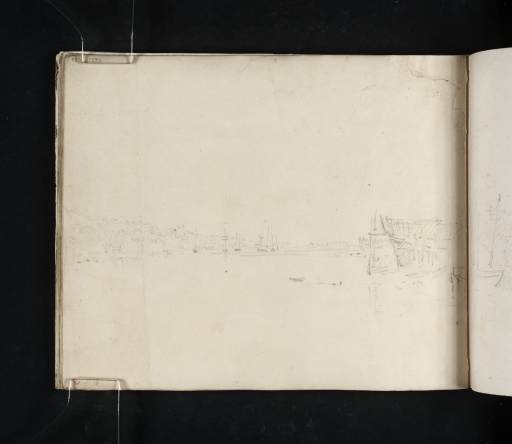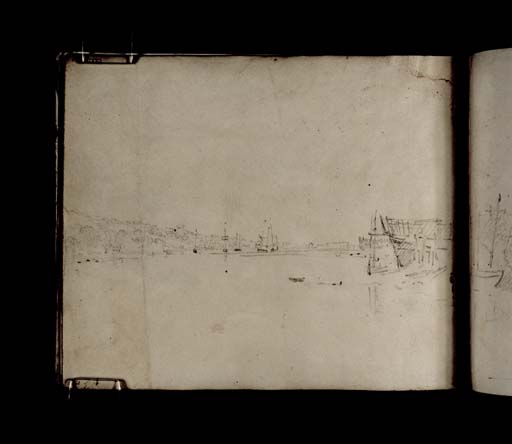Joseph Mallord William Turner Teignmouth from Ringmore, with a Vessel under Construction 1811
Image 1 of 2
Joseph Mallord William Turner,
Teignmouth from Ringmore, with a Vessel under Construction
1811
Joseph Mallord William Turner 1775–1851
Folio 36 Verso:
Teignmouth from Ringmore, with a Vessel under Construction 1811
D08851
Turner Bequest CXXIV 36
Turner Bequest CXXIV 36
Pencil on white wove paper, 170 x 209 mm
Inscribed by John Ruskin in red ink ‘13’ bottom left, upside down
Stamped in black ‘CXXIV – 36’ top left, upside down
Inscribed by John Ruskin in red ink ‘640’ bottom left on the recto (see discussion below)
Inscribed by John Ruskin in red ink ‘13’ bottom left, upside down
Stamped in black ‘CXXIV – 36’ top left, upside down
Inscribed by John Ruskin in red ink ‘640’ bottom left on the recto (see discussion below)
Accepted by the nation as part of the Turner Bequest 1856
References
1909
A.J. Finberg, A Complete Inventory of the Drawings of the Turner Bequest, London 1909, vol.I, p.354, CXXIV 36, as ‘Teignmouth’.
1977
Christopher White, English Landscape 1630–1850: Drawings, Prints & Books from the Paul Mellon Collection, exhibition catalogue, Yale Center for British Art, New Haven 1977, p.75 and note 1 under no.133.
1979
Andrew Wilton, J.M.W. Turner: His Life and Work, Fribourg 1979, p.351 under no.452.
1981
Eric Shanes, Turner’s Rivers, Harbours and Coasts, London 1981, p.152, as CXXIV ‘36a’.
1982
Louis Hawes, Presences of Nature: British Landscape 1780–1830, exhibition catalogue, Yale Center for British Art, New Haven 1982, p.131 under no.II.10.
1982
Evelyn Joll and Martin Butlin, L’opera completa di Turner 1793–1829, Classici dell’arte, Milan 1982, p.101 under no.197.
1984
Martin Butlin and Evelyn Joll, The Paintings of J.M.W. Turner, revised ed., New Haven and London 1984, p.85 under no.120.
1990
Eric Shanes, Turner’s England 1810–38, London 1990, pp.47 under no.24, 283 note 24.
2005
Arthur Ebdon, Turner in Teignmouth, Toby Thorne (ed.), Teignmouth 2005, pp.5, 14, reproduced p.9 (colour).
Arthur Ebdon identifies the location as the Strand at Ringmore, upstream to the west across the River Teign from Teignmouth, and notes that sixty-eight vessels were constructed in the Teignmouth area during the Napoleonic Wars.1 Shaldon Bridge now crosses at about the point where boats are shown beached on the mud flats. There is a view of the same boatyard looking inland on folio 35 verso (D08850).
This page was recorded by Finberg as if it were a recto (without the ‘a’ suffix by which he usually indicates a verso), but the drawing he describes is bound as the verso of the sheet and the ‘recto’ is blank except for Ruskin’s number. However, Finberg brackets this page with folio 37 recto opposite (D08852); they form a continuous composition, but although he recognised this relationship it is unclear whether they were then bound together as they are now. He notes that the double-page sketch is the basis for the watercolour Teignmouth, Devonshire of about 1813 (Yale Center for British Art, New Haven),2 engraved in 1815 for the Picturesque Views on the Southern Coast of England3 (see the concordance of the series in the 1811 tour introduction).
Presumably on the same occasion, Turner also made a less detailed, laterally compressed sketch in the Devonshire Coast, No.1 sketchbook (Tate D08789; Turner Bequest CXXIII 239v). Finberg also noted Turner’s use of the present drawing4 for the oil painting Teignmouth, which he exhibited at his gallery in 1812 (Tate T03882; displayed at Petworth House, West Sussex).5 In both the watercolour and the oil, the full extent of the left-hand (present) page was transcribed, but only a little of the wooded shoreline shown on folio 37 recto was used.
Technical notes:
Significant losses to the top right corner have been replaced. A crease runs for the height of the page towards the left, and the page is darkened outwards to the edge. This corresponds with darkening to the right-hand edge of the opposite page, as though the latter had been exposed for some time to light or dust. This may relate to Turner’s use of the drawing as the basis of his Petworth painting.
Matthew Imms
February 2011
How to cite
Matthew Imms, ‘Teignmouth from Ringmore, with a Vessel under Construction 1811 by Joseph Mallord William Turner’, catalogue entry, February 2011, in David Blayney Brown (ed.), J.M.W. Turner: Sketchbooks, Drawings and Watercolours, Tate Research Publication, December 2012, https://www


